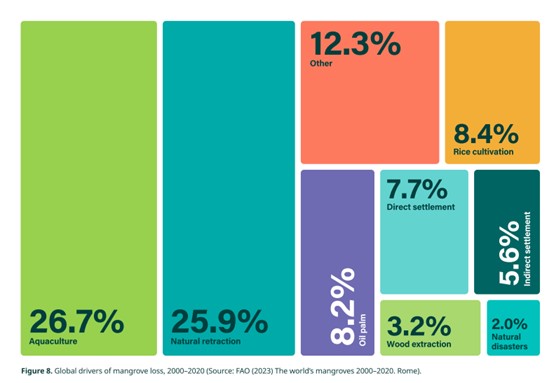Global mangrove crisis: The area continues to shrink, with aquaculture becoming the biggest crowding factor
The Global Mangrove Alliance (GMA) and the World Conservation Union (IUCN) recently released the "State of the World's Mangroves 2024" report, focusing on the current status, changes, driving factors and protection strategies of the global mangrove ecosystem. Reports show that the area of mangrove forests around the world is continuing to decrease. The study used remote sensing technology to analyze changes in mangrove area and estimated that as of 2020, the global mangrove area was 147,800 square kilometers. From 2000 to 2020, the total global mangrove area decreased by 6769 square kilometers, of which 3930 square kilometers were compensated, and the net reduction area was 2839 square kilometers.

The reporter learned that human activities, climate change and other factors pose threats to the survival of mangroves. A new study by the Food and Agriculture Organization of the United Nations (FAO) shows that the main reason for the decline in global mangrove area between 2000 and 2020 was that human activities led to its conversion to aquaculture bases, oil palm plantations, and cultivated land. This loss accounted for 43.3% of the total area. Among them, aquaculture bases accounted for the highest proportion, reaching 26.7%.
The loss of mangrove area caused by climate change is also intensifying. The term "natural retreat" is mentioned in the study to cover the loss of mangrove area caused by riverbed movement, sediment input or sea level rise. Over the past 20 years, the area loss caused by natural shrinkage accounted for 25.9%.

The picture shows the factors affecting the loss of global mangrove area from 2000 to 2020, taken from the "State of the World's Mangroves 2024"
The main drivers vary in different regions. For example, Southeast Asia has one of the largest mangrove areas in the world, but it is also the area with the most serious mangrove losses. Here, agricultural expansion and aquaculture are the main reasons for mangrove loss; in Africa, despite the relatively small area of mangrove forests, it also faces threats from human activities such as urbanization, agricultural expansion and mining; in Latin America, the threats to mangrove forests mainly come from coastal development, illegal logging and climate change.
In fact, mangroves have important "blue carbon" storage functions. The report points out that mangroves can continue to fix carbon stored in marine and coastal ecosystems in the soil, thereby reducing carbon emissions. The latest GMA research shows that on average, mangrove soil and biomass can store 394 tons of carbon per hectare, and mangrove carbon reserves in areas such as the Philippines even exceed 650 tons per hectare. This is crucial for global mitigation and adaptation to climate change.
In addition, mangrove ecosystems have amazing biodiversity, providing habitat for a variety of animals and plants. Scientists have recorded 5746 species of animals and plants in mangroves in India, covering 21 different biological taxa; more than 3000 insects have been recorded in mangroves in Singapore. And one study estimates that about one-third of all wild fish landing in Southeast Asia are fish that rely on mangroves for survival.
In terms of coastal protection, studies have found that mangroves can significantly reduce flood depth, with an average reduction of 15% to 20%, and in some areas, the reduction even exceeds 70%. Continuous mangrove belts can provide more effective protection. This further confirms the role of mangroves in flood control and disaster reduction.
"Protecting mangrove ecosystems is crucial to maintaining the earth's ecological balance and responding to climate change. Comprehensive management and protection measures are needed, including reducing the negative impacts of human activities, strengthening climate change adaptation and promoting the sustainable use of mangroves." The report pointed out.
Currently, 40% of the world's remaining mangroves are classified as protected areas. In countries such as Brazil, Mexico and Bangladesh, more than 75% of mangrove forests are protected; in countries such as Malaysia, Papua New Guinea and Myanmar, less than 5% of the protected area is protected. GMA has set a goal of doubling the mangrove area protected by 2030, from the current 40% to 80%. This is expected to protect approximately 6.1 million hectares of mangrove forests.
However, achieving this goal will not be easy. The report points out that in addition to protected areas, it is now widely recognized that mangrove protection can also be achieved through "other effective regional protection measures (OECM)." These measures point to many potential areas and situations outside the protected area. These measures may not have mangrove protection as their primary purpose, but can still achieve equal and complementary effects as the protected area.
In addition, effective monitoring is crucial to reducing mangrove losses. Currently, the Global Mangrove Watch (GMW) alert system monitors half of the world's mangrove forests and provides monthly updated damage alerts. This allows mangrove guardians to respond quickly as soon as damage is discovered, providing the best time to intervene. From 2019 to the beginning of 2024, the system has issued more than 600,000 alerts. Analysis found that 35% of them are from Myanmar, which also proves that the area is currently the area with the fastest rate of mangrove forest damage.







